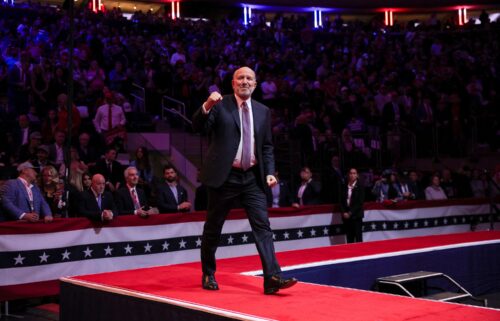In newly unsealed court documents, a detective describes recruitment of dozens of girls for Epstein
By Samantha Delouya, Jeff Winter and Lauren del Valle, CNN
(CNN) — Nineteen unsealed documents from a lawsuit connected to Jeffrey Epstein, the convicted pedophile who died in jail before he could face trial on federal sex-trafficking charges, were publicly released on Thursday.
This is the second batch stemming from a December 18 court order from the judge overseeing the lawsuit, a response to media’s legal efforts to publicly release the documents. The documents on Thursday night total more than 300 pages.
The documents are part of a 2015 civil defamation suit brought by Virginia Roberts Giuffre, an American woman who claimed Epstein sexually abused her as a minor and that Ghislaine Maxwell, Epstein’s former girlfriend, aided in the abuse.
Thursday’s release follows hundreds of pages of documents unsealed on Wednesday, with more expected in the coming weeks.
The documents in total, including material yet to be unsealed, are expected to include nearly 200 names, including some of Epstein’s accusers, prominent businesspeople, politicians and potentially more.
Being named in the unsealed documents does not necessarily mean someone was accused of or committed wrongdoing, though.
The documents range from technical legal arguments and exhibits to depositions recounting allegations and descriptions of alleged crimes, many or all of which appear to have been previously known through other releases, media interviews and other avenues.
One document, a deposition from Palm Beach Detective Joseph Recarey, lays out a process he says Epstein and Maxwell used to find and recruit girls “to perform massages and work at Epstein’s home.” Recarey was the lead detective on a previous case against Epstein in the mid-2000s.
In the document, when asked by an attorney how many girls Recarey had spoken to about being recruited by Maxwell, Recarey answered, “I would say approximately 30; 30, 33.”
The attorney asked Recarey: “And at the end of that massage, if that victim brought other friends, she would get paid for the recruitment of those friends?”
“Correct,” Recarey responded.
At another point, the attorney asked the detective: “So did you determine that ‘massage’ was actually a code word for something else?”
Recarey’s response: “When they went to perform a massage, it was for sexual gratification.”
Another accuser, whose name remains redacted, said in a 2016 deposition that when she was between the age of 15 and 17 she was paid to give Jeffrey Epstein massages even though she had no massage experience. The massage, she had thought, “didn’t involve any sexual activity. That’s what I was under the assumption.”
But she said that assumption was wrong.
“I just was there, and all of a sudden something horrible happened to me,” she said of her experience with Epstein, adding, “it wasn’t supposed to be sexual, but it was.”
She said she brought other high-school girls to Epstein’s home at his request, and that she would get paid when she was at his house even if she did not do anything.
There are still names blacked out in the unsealed documents.
For example, in a 2011 email sent by Sharon Churcher, a reporter from the UK publication Mail on Sunday, to a blacked-out recipient makes reference to someone being trafficked to “men including two of the world’s most respected politicians,” followed by a parenthetical aside including two names redacted by solid black bars.
But there are also some well-known names.
Epstein and the media
In one unsealed email from 2011, Giuffre alleged that former President Bill Clinton threatened the magazine to not write sex-trafficking articles about Epstein.
In the email to Churcher, Giuffre said she was concerned about sharing her story with the publication, “considering that B. Clinton walked into VF and threatened them not to write sex-trafficing [sic] articles about his good friend J.E”.
Giuffre did not specify when Clinton’s interaction she described with Vanity Fair was supposed to have taken place.
Graydon Carter, Vanity Fair’s editor from 1992 to 2017, said in a statement to CNN that the interaction “categorically did not happen.”
A Clinton spokesman told CNN they had no new comment about the alleged incident. On Wednesday, in response to Clinton appearing in the unsealed documents, a Clinton spokesman said it has “been nearly 20 years since President Clinton last had contact with Epstein.”
The first round of documents, released Wednesday, mostly contained names and information that had already been reported in various media outlets and made public through other court proceedings. However, this is the first time these specific documents have been released publicly. More documents may be unsealed in the coming days.
Giuffre and Maxwell settled their civil suit in 2017, but the court filings were previously redacted to protect individuals’ privacy. Some names and information are still blacked out in the unsealed documents.
Most of the documents from the suit were unsealed in 2019, one day before Epstein died by suicide in jail.
Maxwell is currently serving a 20-year sentence in federal prison after being found guilty of sex trafficking in 2021.
In a statement to CNN Wednesday, Maxwell’s attorneys said: “She has consistently and vehemently maintained her innocence.”
Contributing: Curt Devine, Laura Dolan, Riley Gutiérrez McDermid and Kara Scannell.
This story has been updated with additional developments.
The-CNN-Wire
™ & © 2024 Cable News Network, Inc., a Warner Bros. Discovery Company. All rights reserved.

